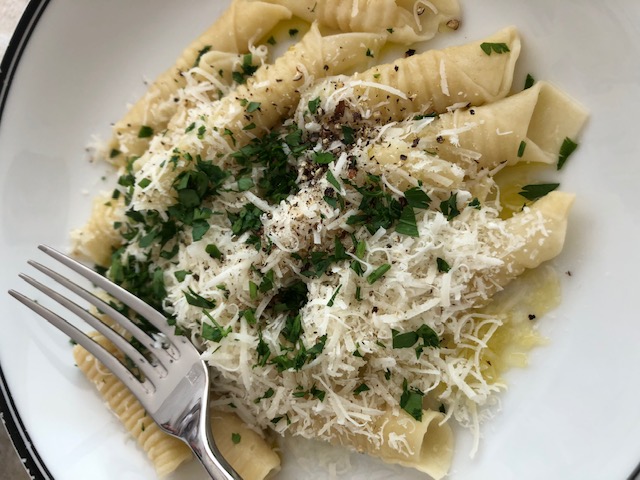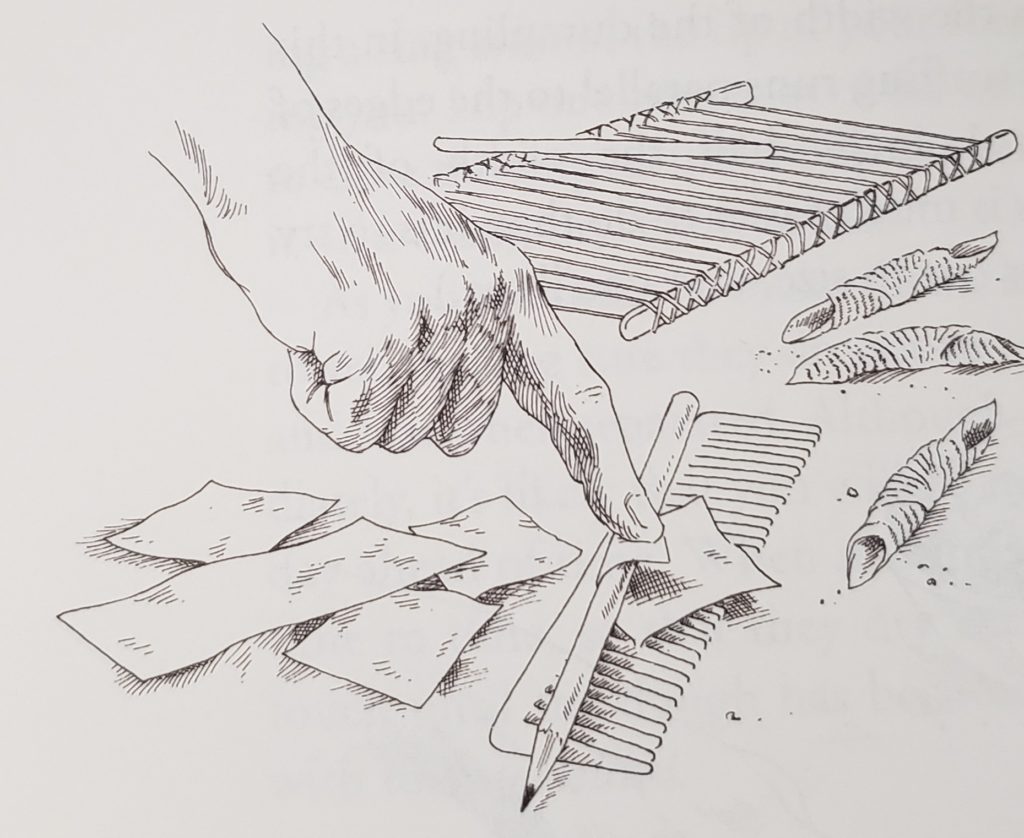We were heartened by everyone’s response to our limited edition of Food and Friendship. Looks like many of you are also cooking up a storm, trying out new recipes and doing some experimenting with what’s in your pantry. Our friend Carole sent us this lovely, organically conceived recipe for a quick pasta with simple ingredients we all probably have hanging out in the house with us. Carole went the extra mile and made pasta dough from scratch. If you’re game, we’ve added the recipe for making fresh pasta. Otherwise, use any short pasta you have around, penne, gemelli, cavatappi, etc.
This recipe was inspired by Carole’s son and girlfriend coming to visit for a few days. We’ll let Carole explain:
Our son Evan, and his girlfriend Juliana came for a short visit and one day I made pasta dough out of sheer covid angst! Then we sat around the table making garganelli, a beautiful sort of floppy angular penne rigate..we had so. much. fun! Sauced it simply with peppery olive oil, pecorino, parsley, and black pepper to taste, and had it for dinner, followed by espresso granita, with a dollop of whipped cream on top.

- 2 cups unbleached all-purpose flour
- 3 eggs
- Having a pasta attachment to your electric mixer is certainly helpful, but a manual pasta roller works very well also. However, if you're going to try making this garganelli shape, you'll need a wooden dowel or pencil and a new clean comb.... see below.
- Heap the flour on a board or counter. Create a hollow round well in the middle (I turn the one cup measure upside down, gently depress). Break the eggs into the well.
- Beat the eggs briefly with a fork, then begin to draw some of the flour in a LITTLE at a time, always mixing with the fork. When a soft paste begins to form, switch to a bench scraper.
- Push all the remaining flour to one side of the board, while you scrape to the other side pieces and bits attached to the board.
- Add to the paste some of the flour you have pushed aside and begin kneading the dough…as you add flour, let your kneading become a little more energetic. Knead the dough, pushing away, turning over, folding…add a bit more flour if it is sticking to the board. Knead for at least 6 minutes, do not skimp on kneading. Place ball of dough on a small clean plate, cover with plastic wrap and let the dough rest for at least 30 minutes.
- The dough is now ready to be rolled out. (I use the Atlas Pasta attachment for the Kitchen Aid stand mixer. However, in past, I have used the Atlas pasta roller which attaches to a table, or an island or some such).
- Here's the tricky part, with thanks to Carole and Marcella Hazan: To make the garganelli, you can use a clean new hair comb with teeth at least 1.5- inches long. You also need a small dowel or a smooth, perfectly round pencil about 6 inches long and ¼-inch in diameter.
- Cut the soft fresh dough into 1.5-inch squares. Lay a clean comb flat on the counter, its teeth pointing away from you; lay a pasta square diagonally on the comb so that one corner points toward you, another toward the tips of the comb's teeth. Place a pencil, or dowel if you have one, on the square and parallel to the comb. Curl the corner of the square facing you around the dowel (pencil) and, with gentle downward pressure, push the dowel (pencil) away from you and off the comb. Tip the dowel (pencil) on its end and a small, ridged tube of pasta will slide off. Spread the garganelli on a clean dry, cloth towel, making sure they do not touch each other. Garganelli cannot be made long in advance and dried like other pasta because they will crack while cooking. They are best cooked immediately, but if you cannot do that, plunge them into boiling water for a few seconds, drain immediately, toss with olive oil, and spread on a tray to cool.
- Carole did use pencils in lieu of traditional wood dowels, and plastic combs in place of the traditional wooden garganelli paddle.
- Let us know if you try this!


- 2½ cups freshly brewed espresso, at room temperature (see headnote)
- ¾ cup plus 3 tablespoons sugar, or more as needed
- 1 cup water
- ½ cup chilled heavy whipping cream
- Kosher salt
- Pour the espresso into a mixing bowl. Add ¾ cup of the sugar and stir until dissolved. Taste it; it should seem a bit too sweet. If it doesn't, add extra sugar by the ¼ teaspoon until it does. Stir in the water. Pour into a shallow stainless-steel or glass pan that's large enough so the mixture is no more than 1 inch deep. Freeze until solid; this may take up to 8 hours.
- Choose a glass, plastic or metal container with a tight-fitting lid. Make sure it is dry, snap on the lid and place it in the freezer.
- Once the espresso mixture has frozen solid, place the pan on a cool surface. Use a metal pastry scraper to cut a grid of evenly spaced lines, left to right and then top to bottom (to create squares). Use the scraper to gently toss the granita, then transfer it to the cold container. Cover and freeze for at least 30 minutes.
- Meanwhile, combine the heavy whipping cream, the 3 tablespoons of sugar and the salt in the bowl of a stand mixer or handheld electric mixer. Beat on medium-low speed until frothy, then on high speed until soft peaks form.
- Just before serving, gently toss the granita with a large fork (to redistribute any separated sugar).
- Layer the granita and dollops of whipped cream alternately, parfait-style, in chilled serving glasses. There should be almost as much whipped cream as granita. Serve right away.
Please keep sending your quarantine-inspired recipes to share. We love hearing from you.